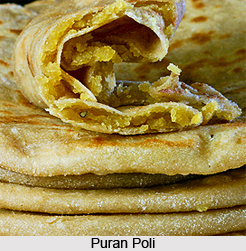 Puran poli is a delicious sweet recipe mostly popular in the Maharashtra state of India. Look wise, this traditional sweet is similar to roti but the preparation is entirely different. The stuffing is known as puran and the outer cover is known as poli. The outer cover of puran poli is prepared by making dough by mixing refined flour, milk and ghee. Equal numbers of balls are made of the dough as well as the stuffing. The preparation of Puran poli varies from place to place.
Puran poli is a delicious sweet recipe mostly popular in the Maharashtra state of India. Look wise, this traditional sweet is similar to roti but the preparation is entirely different. The stuffing is known as puran and the outer cover is known as poli. The outer cover of puran poli is prepared by making dough by mixing refined flour, milk and ghee. Equal numbers of balls are made of the dough as well as the stuffing. The preparation of Puran poli varies from place to place.
Ingredients of Puran Poli
•300gms channa (yellow gram) dal
•300 gms jaggery (molasses)
•1 tsp cardamom powder
•150 gms plain flour
•1 tbsp ghee
•Warm water to knead dough
•Ghee to serve
Method of Preparing Puran Poli
•Boil dal in plenty of water till soft but not broken. Drain in a colander for 10-15 minutes.
•Pass through an almond grater little by little till all dal is grated.
•Mash jaggery till lumps break. Mix well into dal.
•Put mixture in a heavy saucepan and cook till a soft lump is formed. Take care to stir continuously, so as not to char. Keep aside.
•Mix ghee, flour; add enough water to make soft pliable dough.
•Take a morsel sized ball of dough, roll into a 4" round.
•Place same sized ball of filling in centre, life all round and seal.
•Again roll carefully to a 6" diameter round. Roast on warm griddle till golden brown. Repeat other side.
•Take on serving plate.
•Apply a tsp. of ghee all over top.
•Serve hot.
Another method of preparing Puran Poli with little change in the ingredients:
Ingredients of Puran Poli
•450 gms chana dal
•500 gms sugar or jaggery
•250 gms wheat flour
•50 gms flour
•5 tsp oil
•1/2 grated nutmeg
•50 gms powdered cardamom
•Pure ghee for serving
Method of Preparing Puran Poli
•Firstly, wash the chana daal and cook with little water. Drain out the extra water.
•Add sugar or jaggery to the cooked daal and cook on low heat until the mixture becomes thick.
•Remove from heat and pass it through a sieve while still hot.
•Add grated nutmeg and cardamom powder.
•Stir well and remove from heat and keep aside to cool.
•Mix the wheat flour, flour, oil and enough water knead into smooth dough.
•Keep it aside for an hour or two.
•Divide the gram daal mixture into small sized balls and the flour dough into slightly more smaller balls and roll them out a little.
•Place the gram daal ball in the centre of the rolled flour dough and close it to cover the filling completely.
•Roll out into a chapati and bake on a non stick tawa till done on both sides, adding a little ghee around.
•Fry till done.
•Serve hot.
Puran Poli can be served with dal or amti. It gains immense popularity during festivals like gudi padwa (Maharashtrian New Year), Diwali, Rakhi etc.




















